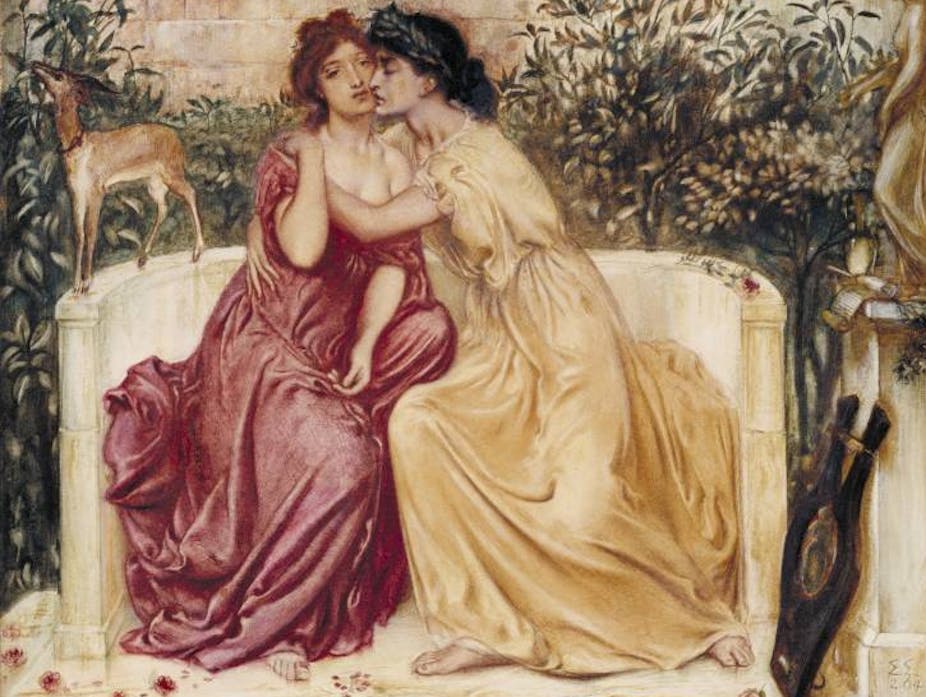It’s a kind of literary miracle. Fragments of two new poems by Ancient Greek poet Sappho have been discovered, making it possible for us to be among the first people to read these texts for more than 1,000 years.
To make matters still more wonderful, the discovery of these poems, first written in the seventh century BC, appears to have happened by pure chance. Apparently, the papyrus that preserved the poems belonged to an anonymous collector who had no idea what it contained, but (fortunately for the world) happened to take it to an expert, Dirk Obbink of Oxford University, who soon realised what he was looking at.
This is the sort of news classical scholars like me normally dream about. In fact, it is the realisation of a game that we spend a lot of time playing over glasses of wine at conference drinks parties: “If you could get back one lost text from any ancient author, which would it be?” And as often as not, Sappho will be the answer.
Why is her work so important? For a start, she’s a wonderful poet, as the ancients recognised when they called her the Tenth Muse. Though little remains of the nine books of her work that once existed, her poetry stands out for its vivid images, and in particular its descriptions of erotic desire. In one fragment she calls love “limb-loosening”, a “sweetbitter irresistible creepy-crawly”, while in one of her most famous poems she describes her feelings of jealousy and passion as the symptoms of a disease:
My tongue has broken, a light fire runs beneath my skin, my eyes see nothing, my ears ring, sweat pours from me, I tremble all over, I am paler than grass …
Quite apart from the quality of the poetry, Sappho also offers us something very rare: a genuine female voice from the ancient world. And of course, what her poems reveal about the expression of lesbian desire in that period make her a fascinating figure. Tantalising scraps survive that describe passionate feelings for different women: we learn of the “bright sparkle” of Anactoria’s face; of Atthis, who has deserted Sappho for a rival named Andromeda and of how Mnasadika has a better figure than Gyrinno.
But who Sappho actually was, and what circumstances she composed her poems in, has been fiercely debated by scholars, since almost everything about her life is uncertain. Many anecdotes are told by ancient biographers, but separating fact from fiction is virtually impossible.
The best preserved of the new poems will open up these questions again, since it deals with two men named Charaxos and Larichos, names which other ancient writers tell us were those of Sappho’s brothers. Charaxos is described as a sea-trader, and the poem begins by expressing concern about whether he will return successfully from his latest voyage. It then moves on to a more philosophical section, discussing the role of the gods in protecting mortals, and ends by turning to the younger man, Larichos, and the hope that he will grow up to be a man and free his family from “heavy-heartedness”.
The poem as a whole creates a sense of anxiety. There is an implication that the future of both men hangs in the balance, and that the family is oppressed by some kind of crisis. This fits with other hints we have about poems in which Sappho describes problems with her brother, since the historian Herodotus mentions a poem in which Sappho ridiculed Charaxos for his foolish love-affair with a courtesan.
We also have a small scrap of another poem by Sappho in which an unnamed brother is described as having made mistakes and brought grief to his family. The new poem suggests Sappho wrote a sequence of poems about the careers and mistakes of her brothers, and show us that she is a poet interested in power, aristocratic prestige, and economics, as well as in personal love-affairs. Whether or not these stories reflect any kind of biographical truth, or are just a literary invention, is something that scholars will no doubt debate for years to come.
The discovery of an entirely unknown papyrus from around the third century AD also raises hopes as to what else might be left for us to find. There are thousands of unpublished papyrus fragments in university collections. Many of them come from Greco-Roman settlements in Egypt, where the dry sands preserved discarded books and papers that would have rotted in the damp soil of Europe.
Still, it’s rare to find something as substantial and as well preserved as this new discovery, and papyrologists often have to satisfy themselves with a few tattered lines. Undergraduates studying classical literature are often told the depressing statistic that at least 90% of it has been lost.
The thread that connects us to the ancient past is incredibly fragile, and it could be broken each time a medieval monk decided not to copy a text, a fire or flood destroyed a precious manuscript collection, or a book failed to make it onto a school syllabus. But if this papyrus survived, who knows what other lost gems may be waiting in libraries, archives, or tucked away in basements or attics.

